Unveiling Light-Absorbing Carbonaceous Aerosols at a Regional Background Site in Southern Balkans
Abstract
1. Introduction
2. Study Region
3. Dataset and Methodology
4. Results and Discussion
4.1. BC Concentrations
4.2. Absorption Characteristics
4.3. Brown Carbon Absorption Properties
4.4. AAE Values for Total and BrC Absorption
5. Conclusions
Author Contributions
Funding
Institutional Review Board Statement
Informed Consent Statement
Data Availability Statement
Acknowledgments
Conflicts of Interest
Abbreviations
| AAE | Absorption Ångstrôm Exponent |
| babs,λ | Spectral light-absorption coefficient |
| BB | Biomass burning |
| BC | Black Carbon |
| BCbb | BC from biomass burning |
| BCff | BC from fossil fuel combustion |
| BrC | Brown Carbon |
| EC | Elemental Carbon |
| H | Harmonization factor |
| MAE | Mass absorption efficiency |
| MLH | Mixing layer height |
| OM | Organic matter |
| RWB | Residential wood burning |
| SOA | Secondary organic aerosols |
| UoWM | University of Western Macedonia |
References
- Bond, T.C.; Doherty, S.J.; Fahey, D.W.; Forster, P.M.; Berntsen, T.; DeAngelo, B.J. Bounding the Role of Black Carbon in the Climate System: A Scientific Assessment. J. Geophys. Res. 2013, 118, 5380–5552. [Google Scholar] [CrossRef]
- Grahame, T.J.; Klemm, R.; Schlesinger, R.B. Public Health and Components of Particulate Matter: The Changing Assessment of Black Carbon. J. Air Waste Manag. Assoc. 2014, 64, 620–660. [Google Scholar] [CrossRef]
- Mallet, M.D.; D’Anna, B.; Même, A.; Bove, M.C.; Cassola, F.; Pace, G.; Desboeufs, K.; Di Biagio, C.; Doussin, J.-F.; Maille, M.; et al. Summertime Surface PM1 Aerosol Composition and Size by Source Region at the Lampedusa Island in the Central Mediterranean Sea. Atmos. Chem. Phys. 2019, 19, 11123–11142. [Google Scholar] [CrossRef]
- Wang, Q.; Li, L.; Zhou, J.; Ye, J.; Dai, W.; Liu, H.; Zhang, Y.; Zhang, R.; Tian, J.; Chen, Y.; et al. Measurement Report: Source and Mixing State of Black Carbon Aerosol in the North China Plain: Implications for Radiative Effect. Atmos. Chem. Phys. 2020, 20, 15427–15442. [Google Scholar] [CrossRef]
- Chen, G.; Canonaco, F.; Slowik, J.G.; Daellenbach, K.R.; Tobler, A.; Petit, J.-E.; Favez, O.; Stavroulas, I.; Mihalopoulos, N.; Gerasopoulos, E.; et al. Real-Time Source Apportionment of Organic Aerosols in Three European Cities. Environ. Sci. Technol. 2022, 56, 15290–15297. [Google Scholar] [CrossRef]
- Srinivas, B.; Rastogi, N.; Sarin, M.M.; Singh, A.; Singh, D. Mass Absorption Efficiency of Light Absorbing Organic Aerosols from Source Region of Paddy-Residue Burning Emissions in the Indo-Gangetic Plain. Atmos. Environ. 2016, 125, 360–370. [Google Scholar] [CrossRef]
- Yan, J.; Wang, X.; Gong, P.; Wang, C.; Cong, Z. Review of Brown Carbon Aerosols: Recent Progress and Perspectives. Sci. Total Environ. 2018, 634, 1475–1485. [Google Scholar] [CrossRef]
- Ferrero, L.; Gregorič, A.; Močnik, G.; Rigler, M.; Cogliati, S.; Barnaba, F.; Liberto, L.; Gobbi, G.P.; Losi, N.; Bolzacchini, E. The Impact of Cloudiness and Cloud Type on the Atmospheric Heating Rate of Black and Brown Carbon in the Po Valley. Atmos. Chem. Phys. 2021, 21, 4869–4897. [Google Scholar] [CrossRef]
- Sun, J.; Xie, C.; Xu, W.; Chen, C.; Ma, N.; Xu, W.; Lei, L.; Li, Z.; He, Y.; Qiu, Y.; et al. Light Absorption of Black Carbon and Brown Carbon in Winter in North China Plain: Comparisons between Urban and Rural Sites. Sci. Total Environ. 2021, 770, 144821. [Google Scholar] [CrossRef]
- Pokhrel, R.P.; Beamesderfer, E.R.; Wagner, N.L.; Langridge, J.M.; Lack, D.A.; Jayarathne, T.; Stone, E.A.; Stockwell, C.E.; Yokelson, R.J.; Murphy, S.M. Relative Importance of Black Carbon, Brown Carbon, and Absorption Enhancement from Clear Coatings in Biomass Burning Emissions. Atmos. Chem. Phys. 2017, 17, 5063–5078. [Google Scholar] [CrossRef]
- Rana, A.; Jia, S.; Sarkar, S. Black Carbon Aerosol in India: A Comprehensive Review of Current Status and Future Prospects. Atmos. Res. 2019, 218, 207–230. [Google Scholar] [CrossRef]
- Barreira, L.M.F.; Aurela, M.; Saarikoski, S.; Li, D.; Teinilä, K.; Virkkula, A.; Niemi, J.V.; Manninen, H.E.; Pirjola, L.; Petäjä, T.; et al. Characterizing Winter-Time Brown Carbon: Insights into Chemical and Light-Absorption Properties in Residential and Traffic Environments. Sci. Total Environ. 2024, 955, 177089. [Google Scholar] [CrossRef] [PubMed]
- Tao, Y.; Yang, Z.; Tan, X.; Cheng, P.; Wu, C.; Li, M.; Sun, Y.; Ma, N.; Dong, Y.; Zhang, J. Light Absorption Properties of Brown Carbon Aerosol During Winter at a Polluted Rural Site in the North China Plain. Atmosphere 2024, 15, 1294. [Google Scholar] [CrossRef]
- Saleh, R.; Robinson, E.S.; Tkacik, D.S.; Ahern, A.T.; Liu, S.; Aiken, A.C.; Sullivan, R.C.; Presto, A.A.; Dubey, M.K.; Yokelson, R.J.; et al. Brownness of Organics in Aerosols from Biomass Burning Linked to Their Black Carbon Content. Nat. Geosci. 2014, 7, 647–650. [Google Scholar] [CrossRef]
- Wang, Q.; Han, Y.; Ye, J.; Liu, S.; Pongpiachan, S.; Zhang, N. High Contribution of Secondary Brown Carbon to Aerosol Light Absorption in the Southeastern Margin of Tibetan Plateau. Geophys. Res. Lett. 2019, 46, 4962–4970. [Google Scholar] [CrossRef]
- Feng, Y.; Ramanathan, V.; Kotamarthi, V.R. Brown Carbon: A Significant Atmospheric Absorber of Solar Radiation? Atmos. Chem. Phys. 2013, 13, 8607–8621. [Google Scholar] [CrossRef]
- Pani, S.K.; Lin, N.-H.; Griffith, S.M.; Chantara, S.; Lee, C.-T.; Thepnuan, D.; Tsai, Y.I. Brown Carbon Light Absorption over an Urban Environment in Northern Peninsular Southeast Asia. Environ. Pollut. 2021, 276, 116735. [Google Scholar] [CrossRef] [PubMed]
- Yuan, W.; Huang, R.-J.; Yang, L.; Guo, J.; Chen, Z.; Duan, J.; Wang, T.; Ni, H.; Han, Y.; Li, Y.; et al. Characterization of the Light-Absorbing Properties, Chromophore Composition and Sources of Brown Carbon Aerosol in Xi’an, Northwestern China. Atmos. Chem. Phys. 2020, 20, 5129–5144. [Google Scholar] [CrossRef]
- Afsana, S.; Zhou, R.; Miyazaki, Y.; Tachibana, E.; Deshmukh, D.K.; Kawamura, K.; Mochida, M. Abundance, Chemical Structure, and Light Absorption Properties of Humic-like Substances (HULIS) and Other Organic Fractions of Forest Aerosols in Hokkaido. Sci. Rep. 2022, 12, 14379. [Google Scholar] [CrossRef]
- Tang, R.; Cui, W.; Zhang, X.; Tan, Y. Light Absorption of Black and Brown Carbon in Eastern China. J. Hazard. Mater. 2025, 489, 137530. [Google Scholar] [CrossRef]
- Zanatta, M.; Gysel, M.; Bukowiecki, N.; Müller, T.; Weingartner, E.; Areskoug, H.; Fiebig, M.; Yttri, K.E.; Mihalopoulos, N.; Kouvarakis, G.; et al. A European Aerosol Phenomenology-5: Climatology of Black Carbon Optical Properties at 9 Regional Background Sites across Europe. Atmos. Environ. 2016, 145, 346–364. [Google Scholar] [CrossRef]
- Bressi, M.; Cavalli, F.; Putaud, J.P.; Fröhlich, R.; Petit, J.-E.; Aas, W. A European Aerosol Phenomenology—7: High-Time Resolution Chemical Characteristics of Submicron Particulate Matter across Europe. Atmos. Environ. 2021, 10, 100108. [Google Scholar] [CrossRef]
- Rovira, J.; Savadkoohi, M.; Chen, G.I.; Močnik, G.; Aas, W.; Alados-Arboledas, L. European aerosol phenomenology—9: Light absorption properties of carbonaceous aerosol particles across surface Europe. Environ. Int. 2025, 195, 109185. [Google Scholar] [CrossRef] [PubMed]
- Diapouli, E.; Kalogridis, A.C.; Markantonaki, C.; Vratolis, S.; Fetfatzis, P.; Colombi, C.; Eleftheriadis, K. Annual Variability of Black Carbon Concentrations Originating from Biomass and Fossil Fuel Combustion for the Suburban Aerosol in Athens, Greece. Atmosphere 2017, 8, 234. [Google Scholar] [CrossRef]
- Katsanos, D.; Bougiatioti, A.; Liakakou, E.; Kaskaoutis, D.G.; Stavroulas, I.; Paraskevopoulou, D.; Lianou, M.; Psiloglou, B.E.; Gerasopoulos, E.; Pilinis, C.; et al. Optical Properties of Near-Surface Urban Aerosols and Their Chemical Tracing in a Mediterranean City (Athens). Aerosol Air Qual. Res. 2019, 19, 49–70. [Google Scholar] [CrossRef]
- Liakakou, E.; Stavroulas, I.; Kaskaoutis, D.G.; Grivas, G.; Paraskevopoulou, D.; Dumka, U.C.; Tsagkaraki, M.; Bougiatioti, A.; Oikonomou, K.; Sciare, J.; et al. Long-Term Variability, Source Apportionment and Spectral Properties of Black Carbon at an Urban Background Site in Athens, Greece. Atmos. Environ. 2020, 222, 117137. [Google Scholar] [CrossRef]
- Liakakou, E.; Kaskaoutis, D.G.; Grivas, G.; Stavroulas, I.; Tsagkaraki, M.; Paraskevopoulou, D.; Bougiatioti, A.; Dumka, U.C.; Gerasopoulos, E.; Mihalopoulos, N. Long-Term Brown Carbon Spectral Characteristics in a Mediterranean City (Athens). Sci. Total Environ. 2020, 708, 135019. [Google Scholar] [CrossRef] [PubMed]
- Kaskaoutis, D.G.; Grivas, G.; Stavroulas, I.; Bougiatioti, A.; Liakakou, E.; Dumka, U.C.; Gerasopoulos, E.; Mihalopoulos, N. Apportionment of Black and Brown Carbon Spectral Absorption Sources in the Urban Environment of Athens, Greece, during Winter. Sci. Total Environ. 2021, 801, 149739. [Google Scholar] [CrossRef]
- Kaskaoutis, D.G.; Grivas, G.; Oikonomou, K.; Tavernaraki, P.; Papoutsidaki, K.; Tsagkaraki, M.; Stavroulas, I.; Zarmpas, P.; Paraskevopoulou, D.; Bougiatioti, A.; et al. Impacts of Severe Residential Wood Burning on Atmospheric Processing, Watersoluble Organic Aerosol and Light Absorption, in an Inland City of Southeastern Europe. Atmos. Environ. 2022, 280, 119139. [Google Scholar] [CrossRef]
- Paraskevopoulou, D.; Kaskaoutis, D.G.; Grivas, G.; Bikkina, S.; Tsagkaraki, M.; Vrettou, I.M.; Tavernaraki, K.; Papoutsidaki, K.; Stavroulas, I.; Liakakou, E.; et al. Brown Carbon Absorption and Radiative Effects under Intense Residential Wood Burning Conditions in Southeastern Europe: New Insights into the Abundance and Absorptivity of Methanol-Soluble Organic Aerosols. Sci. Total Environ. 2023, 860, 160434. [Google Scholar] [CrossRef]
- Kodros, J.K.; Papanastasiou, D.K.; Paglione, M.; Masiola, M.; Squizzato, S.; Florou, K.; Skyllakou, K.; Kaltsonoudis, C.; Nenes, A.; Pandis, S.N. Rapid Dark Aging of Biomass Burning as an Overlooked Source of Oxidized Organic Aerosol. Proc. Natl. Acad. Sci. USA 2020, 117, 33028–33033. [Google Scholar] [CrossRef] [PubMed]
- Jorga, S.D.; Florou, K.; Kaltsonoudis, C.; Kodros, J.K.; Vasilakopoulou, C.; Cirtog, M.; Fouqueau, A.; Picquet-Varrault, B.; Nenes, A.; Pandis, S.N. Nighttime Chemistry of Biomass Burning Emissions in Urban Areas: A Dual Mobile Chamber Study. Atmos. Chem. Phys. 2021, 21, 15337–15349. [Google Scholar] [CrossRef]
- Giannoni, M.; Martellini, T.; Del Bubba, M.; Gambaro, A.; Zangrando, R.; Chiari, M.; Lepri, L.; Cincinelli, A. The Use of Levoglucosan for Tracing Biomass Burning in PM2.5 Samples in Tuscany (Italy). Environ. Pollut. 2012, 167, 7–15. [Google Scholar] [CrossRef]
- Costabile, F.; Gilardoni, S.; Barnaba, F.; Di Ianni, A.; Di Liberto, L.; Dionisi, D.; Manigrasso, M.; Paglione, M.; Poluzzi, V.; Rinaldi, M.; et al. Characteristics of Brown Carbon in the Urban Po Valley Atmosphere. Atmos. Chem. Phys. 2017, 17, 313–326. [Google Scholar] [CrossRef]
- Titos, G.; del Águila, A.; Cazorla, A.; Lyamani, H.; Casquero-Vera, J.A.; Colombi, C.; Cuccia, E.; Gianelle, V.; Močnik, G.; Alastuey, A.; et al. Spatial and Temporal Variability of Carbonaceous Aerosols: Assessing the Impact of Biomass Burning in the Urban Environment. Sci. Total Environ. 2017, 578, 613–625. [Google Scholar] [CrossRef]
- Bigi, A.; Veratti, G.; Andrews, E.; Collaud Coen, M.; Guerrieri, L.; Bernardoni, V.; Massabò, D.; Ferrero, L.; Teggi, S.; Ghermandi, G. Aerosol Absorption Using in Situ Filter-Based Photometers and Ground-Based Sun Photometry in the Po Valley Urban Atmosphere. Atmos. Chem. Phys. 2023, 23, 14841–14869. [Google Scholar] [CrossRef]
- Kaskaoutis, D.G.; Kharol, S.K.; Sifakis, N.; Nastos, P.T.; Sharma, A.R.; Badarinath, K.V.S.; Kambezidis, H.D. Satellite Monitoring of the Biomass-Burning Aerosols during the Wildfires of August 2007 in Greece: Climate Implications. Atmos. Environ. 2011, 45, 716–726. [Google Scholar] [CrossRef]
- Masoom, A.; Fountoulakis, I.; Kazadzis, S.; Raptis, I.-P.; Kampouri, A.; Psiloglou, B.; Kouklaki, D. Investigation of the Effects of the Greek Extreme Wildfires of August 2021 on Air Quality and Spectral Solar Irradiance. Atmos. Chem. Phys. 2023, 23, 8487–8514. [Google Scholar] [CrossRef]
- Michailidis, K.; Garane, K.; Karagkiozidis, D. Extreme Wildfires over Northern Greece during Summer 2023—Part A: Effects on Aerosol Optical Properties and Solar UV Radiation. Atmos. Res. 2024, 311, 107700. [Google Scholar] [CrossRef]
- Koukouli, M.-E.; Pseftogkas, A.; Karagkiozidis, D.; Mermigkas, M.; Panou, T.; Balis, D.; Bais, A. Extreme Wildfires over Northern Greece during Summer 2023—Part B. Adverse Effects on Regional Air Quality. Atmos. Res. 2025, 320, 108034. [Google Scholar] [CrossRef]
- Bougiatioti, A.; Stavroulas, I.; Kostenidou, E.; Zarmpas, P.; Theodosi, C.; Kouvarakis, G.; Canonaco, F.; Prévôt, A.S.H.; Nenes, A.; Pandis, S.N.; et al. Processing of Biomass-Burning Aerosol in the Eastern Mediterranean during Summertime. Atmos. Chem. Phys. 2014, 14, 4793–4807. [Google Scholar] [CrossRef]
- Tsiaousidis, D.T.; Liora, N.; Kontos, S.; Poupkou, A.; Akritidis, D.; Melas, D. Evaluation of PM Chemical Composition in Thessaloniki, Greece Based on Air Quality Simulations. Sustainability 2023, 15, 10034. [Google Scholar] [CrossRef]
- Florou, K.; Liangou, A.; Kaltsonoudis, C.; Louvaris, E.; Tasoglou, A.; Patoulias, D.; Kouvarakis, G.; Kalivitis, N.; Kourtchev, I.; Kalberer, M.; et al. Chemical Characterization and Sources of Background Aerosols in the Eastern Mediterranean. Atmos. Environ. 2024, 324, 120423. [Google Scholar] [CrossRef]
- Hristova, E.; Veleva, B.; Georgieva, E.; Branzov, H. Application of Positive Matrix Factorization Receptor Model for Source Identification of PM10 in the City of Sofia, Bulgaria. Atmosphere 2020, 11, 890. [Google Scholar] [CrossRef]
- Hristova, E.; Georgieva, E.; Veleva, B.; Neykova, N.; Naydenova, S.; Gonsalvesh-Musakova, L.; Neykova, R.; Petrov, A. Black Carbon in Bulgaria—Observed and Modelled Concentrations in Two Cities for Two Months. Atmosphere 2022, 13, 213. [Google Scholar] [CrossRef]
- Papanikolaou, C.-A.; Papayannis, A.; Mylonaki, M.; Foskinis, R.; Kokkalis, P.; Liakakou, E.; Stavroulas, I.; Soupiona, O.; Hatzianastassiou, N.; Gavrouzou, M.; et al. Vertical Profiling of Fresh Biomass Burning Aerosol Optical Properties over the Greek Urban City of Ioannina, during the PANACEA Winter Campaign. Atmosphere 2022, 13, 94. [Google Scholar] [CrossRef]
- Fourtziou, L.; Liakakou, E.; Stavroulas, I.; Theodosi, C.; Zarmpas, P.; Psiloglou, B.; Sciare, J.; Maggos, T.; Bairachtari, K.; Bougiatioti, A.; et al. Multi-Tracer Approach to Characterize Domestic Wood Burning in Athens (Greece) during Wintertime. Atmos. Environ. 2017, 148, 89–101. [Google Scholar] [CrossRef]
- Kalogridis, A.-C.; Vratolis, S.; Liakakou, E.; Gerasopoulos, E.; Mihalopoulos, N.; Eleftheriadis, K. Assessment of Wood Burning versus Fossil Fuel Contribution to Wintertime Black Carbon and Carbon Monoxide Concentrations in Athens, Greece. Atmos. Chem. Phys. 2018, 18, 10219–10236. [Google Scholar] [CrossRef]
- Voudouri, K.A.; Michailidis, K.; Siomos, N.; Chatzopoulou, A.; Kouvarakis, G.; Mihalopoulos, N.; Tzoumaka, P.; Kelessis, A.; Balis, D. Evaluation of Aerosol Typing with Combination of Remote Sensing Techniques with In Situ Data during the PANACEA Campaigns in Thessaloniki Station, Greece. Remote Sens. 2022, 14, 5076. [Google Scholar] [CrossRef]
- Kaskaoutis, D.G.; Grivas, G.; Theodosi, C.; Tsagkaraki, M.; Paraskevopoulou, D.; Stavroulas, I.; Liakakou, E.; Gkikas, A.; Hatzianastassiou, N.; Wu, C.; et al. Carbonaceous Aerosols in Contrasting Atmospheric Environments in Greek Cities: Evaluation of the EC-Tracer Methods for Secondary Organic Carbon Estimation. Atmosphere 2020, 11, 161. [Google Scholar] [CrossRef]
- Florou, K.; Papanastasiou, D.K.; Pikridas, M.; Kaltsonoudis, C.; Louvaris, E.; Gkatzelis, G.I.; Patoulias, D.; Mihalopoulos, N.; Pandis, S.N. The Contribution of Wood Burning and Other Pollution Sources to Wintertime Organic Aerosol Levels in Two Greek Cities. Atmos. Chem. Phys. 2017, 17, 3145–3163. [Google Scholar] [CrossRef]
- Voutsa, D.; Terzi, H.; Muller, L.; Samara, C.; Kouimtzis, T. Profile Analysis of Organic Micropollutants in the Environment of a Coal Burning Area, NW Greece. Chemosphere 2004, 55, 595–604. [Google Scholar] [CrossRef]
- Iordanidis, A.; Garcia-Guinea, J.; Garas, S.; Asvesta, A.; Triantafyllou, A.G. Application of μRaman Microscopy to the Identification of Individual Airborne Particles: Preliminary Results from Kozani’s Area, Northern Greece. Part. Sci. Technol. 2014, 32, 355–359. [Google Scholar] [CrossRef]
- Triantafyllou, A.; Moussiopoulos, N.; Krestou, A.; Tsegas, G.; Barmpas, F.; Garas, S.; Andreadou, M. Application of Inverse Dispersion Modelling for the Determination of PM Emission Factors from Fugitive Dust Sources in Open-Pit Lignite Mines. Int. J. Environ. Pollut. 2017, 62, 274–290. [Google Scholar] [CrossRef]
- Lin, W.; Huang, W.; Zhu, T.; Hu, M.; Brunekreef, B.; Zhang, Y.; Liu, X.; Cheng, H.; Gehring, U.; Li, C.; et al. Acute Respiratory Inflammation in Children and Black Carbon in Ambient Air before and during the 2008 Beijing Olympics. Environ. Health Perspect. 2011, 119, 1507–1512. [Google Scholar] [CrossRef]
- Saenen, N.D.; Provost, E.B.; Viaene, M.K.; Vanpoucke, C.; Lefebvre, W.; Vrijens, K.; Roels, H.A.; Nawrot, T.S. Recent versus Chronic Exposure to Particulate Matter Air Pollution in Association with Neurobehavioral Performance in a Panel Study of Primary Schoolchildren. Environ. Int. 2016, 95, 112–119. [Google Scholar] [CrossRef] [PubMed]
- Samara, C.; Argyropoulos, G.; Grigoratos, T.; Kouras, A.; Manoli, Ε.; Andreadou, S.; Pavloudakis, F.; Sahanidis, C. Chemical Characterization and Receptor Modeling of PM10 in the Surroundings of the Opencast Lignite Mines of Western Macedonia, Greece. Environ. Sci. Pollut. Res. 2018, 25, 12206–12221. [Google Scholar] [CrossRef]
- Chatzitheodoridis, F.; Kolokontes, A.D.; Vasiliadis, L. Lignite Mining and Lignite-Fired Power Generation in Western Macedonia of Greece: Economy and Environment. J. Energy Dev. 2008, 33, 267–282. [Google Scholar]
- Petaloti, C.; Triantafyllou, A.; Kouimtzis, T.; Samara, C. Trace Elements in Atmospheric Particulate Matter over a Coal Burning Power Production Area of Western Macedonia, Greece. Chemosphere 2006, 65, 2233–2243. [Google Scholar] [CrossRef]
- Tolis, E.; Saraga, D.; Ammari, G.; Gkanas, E.; Gougoulas, T.; Papaioannou, C.; Sarioglou, A.; Kougioumtzidis, E.; Skemperi, A.; Bartzis, J. Chemical Characterization of Particulate Matter (PM) and Source Apportionment Study during Winter and Summer Period for the City of Kozani, Greece. Open Chem. 2014, 12, 643–651. [Google Scholar] [CrossRef]
- Gkaras, S.; Triantafyllou, E.; Dougali, A.; Diamantopoulos, C.; Tolis, E.; Triantafyllou, A. Source Apportionment of the Atmospheric Aerosol in Western Macedonia, GREECE, Part 1: Concentrations of Metallic Components, Major Ions, and PAHs in PM10 Samples. Environ. Sci. Proc. 2023, 26, 85. [Google Scholar] [CrossRef]
- Pavloudakis, F.; Sachanidis, C.; Roumpos, C. The Effects of Surface Lignite Mines Closure on the Particulates Concentrations in the Vicinity of Large-Scale Extraction Activities. Minerals 2022, 12, 347. [Google Scholar] [CrossRef]
- Tranoulidis, A.; Sotiropoulou, R.-E.P.; Bithas, K.; Tagaris, E. Decarbonization and Transition to the Post-Lignite Era: Analysis for a Sustainable Transition in the Region of Western Macedonia. Sustainability 2022, 14, 10173. [Google Scholar] [CrossRef]
- Matthaios, V.N.; Triantafyllou, A.G.; Koutrakis, P. PM10 Episodes in Greece: Local Sources versus Long-Range Transport—Observations and Model Simulations. J. Air Waste Manag. Assoc. 2017, 67, 105–126. [Google Scholar] [CrossRef]
- Triantafyllou, A.; Andreadou, S.; Moussiopoulos, N.; Garas, S.; Kapageridis, I.; Tsegas, G.; Diamantopoulos, C.; Sachanidis, C.; Skordas, I. Surface Mining in Western Macedonia, Greece: Fugitive Dust (PM10) Emissions and Dispersion. Int. J. Min. Miner. Eng. 2019, 10, 288–310. [Google Scholar] [CrossRef]
- Drinovec, L.; Močnik, G.; Zotter, P.; Prévôt, A.S.H.; Ruckstuhl, C.; Coz, E.; Rupakheti, M.; Sciare, J.; Müller, T.; Wiedensohler, A.; et al. The “Dual-Spot” Aethalometer: An Improved Measurement of Aerosol Black Carbon with Real-Time Loading Compensation. Atmos. Meas. Tech. 2015, 8, 1965–1979. [Google Scholar] [CrossRef]
- Sandradewi, J.; Prévôt, A.S.H.; Weingartner, E.; Schmidhauser, R.; Gysel, M.; Baltensperger, U. A Study of Wood Burning and Traffic Aerosols in an Alpine Valley Using a Multi-Wavelength Aethalometer. Atmos. Environ. 2008, 42, 101–112. [Google Scholar] [CrossRef]
- Dumka, U.C.; Kaskaoutis, D.G.; Tiwari, S.; Safai, P.D.; Attri, S.D.; Soni, V.K.; Singh, N.; Mihalopoulos, N. Assessment of Biomass Burning and Fossil Fuel Contribution to Black Carbon Concentrations in Delhi during Winter. Atmos. Environ. 2018, 194, 93–109. [Google Scholar] [CrossRef]
- Zheng, H.; Kong, S.; Chen, N.; Fan, Z.; Zhang, Y.; Yao, L.; Cheng, Y.; Zheng, S.; Yan, Y.; Liu, D.; et al. A Method to Dynamically Constrain Black Carbon Aerosol Sources with Online Monitored Potassium. npj Clim. Atmos. Sci. 2021, 4, 43. [Google Scholar] [CrossRef]
- Savadkoohi, M.; Gherras, M.; Favez, O.; Petit, J.-E.; Rovira, J.; Chen, G.I.; Via, M.; Platt, S.; Aurela, M.; Chazeau, B.; et al. Addressing the Advantages and Limitations of Using Aethalometer Data to Determine the Optimal Absorption Ångström Exponents (AAEs) Values for eBC Source Apportionment. Atmos. Environ. 2025, 349, 121121. [Google Scholar] [CrossRef]
- Ivančič, M.; Gregorič, A.; Lavrič, G.; Alföldy, B.; Ježek, I.; Hasheminassab, S.; Pakbin, P.; Ahangar, F.; Sowlat, M.; Boddeker, S.; et al. Two-Year-Long High-Timeresolution Apportionment of Primary and Secondary Carbonaceous Aerosols in the Los Angeles Basin Using an Advanced Total Carbon–Black Carbon (TC-BC(λ)) Method. Sci. Total Environ. 2022, 848, 157606. [Google Scholar] [CrossRef]
- Zhang, K.M.; Allen, G.; Yang, B.; Chen, G.; Gu, J.; Schwab, J.; Felton, D.; Rattigan, O. Joint Measurements of PM2. 5 and Light-Absorptive PM in Woodsmoke-Dominated Ambient and Plume Environments. Atmos. Chem. Phys. 2017, 17, 11441–11452. [Google Scholar] [CrossRef]
- Kumar, N.K.; Corbin, J.C.; Bruns, E.A.; Massabó, D.; Slowik, J.G.; Drinovec, L.; Močnik, G.; Prati, P.; Vlachou, A.; Baltensperger, U.; et al. Production of Particulate Brown Carbon during Atmospheric Aging of Residential Wood-Burning Emissions. Atmos. Chem. Phys. 2018, 18, 17843–17861. [Google Scholar] [CrossRef]
- Gilardoni, S.; Massoli, P.; Marinoni, A.; Mazzoleni, C.; Freedman, A.; Lonati, G.; Iuliis, S.D.; Gianelle, V. Spatial and Temporal Variability of Carbonaceous Aerosol Absorption in the Po Valley. Aerosol Air Qual. Res. 2020, 20, 2624–2639. [Google Scholar] [CrossRef]
- Yus-Díez, J.; Bernardoni, V.; Močnik, G.; Alastuey, A.; Ciniglia, D.; Ivančič, M.; Querol, X.; Perez, N.; Reche, C.; Rigler, M.; et al. Determination of the Multiple-Scattering Correction Factor and Its Cross-Sensitivity to Scattering and Wavelength Dependence for Different AE33 Aethalometer Filter Tapes: A Multi-Instrumental Approach. Atmos. Meas. Tech. 2021, 14, 6335–6355. [Google Scholar] [CrossRef]
- Retama, A.; Ramos-Cerόn, M.; Rivera-Hernández, O.; Allen, G.; Velasco, E. Aerosol Optical Properties and Brown Carbon in Mexico City. Environ. Sci. Atmos. 2022, 2, 315–334. [Google Scholar] [CrossRef]
- Kaskaoutis, D.G.; Grivas, G.; Stavroulas, I.; Liakakou, E.; Dumka, U.C.; Gerasopoulos, E.; Mihalopoulos, N. Effect of Aerosol Types from Various Sources at an Urban Location on Spectral Curvature of Scattering and Absorption Coefficients. Atmos. Res. 2021, 264, 105865. [Google Scholar] [CrossRef]
- Sotiropoulou, R.E.P.; Kaskaoutis, D.G.; Kalkavouras, P.; Grivas, G.; Petrinoli, K.; Garas, S.K.; Liakakou, E.; Tagaris, E.; Mihalopoulos, N. Spatial variability of carbonaceous aerosols and absorption characteristics between urban background and residential sites during wintertime at a major Mediterranean city (Athens; Greece). Atmos. Res. 2025, 323, 108163. [Google Scholar] [CrossRef]
- Zhao, Z.; Cao, J.; Chow, J.C.; Watson, J.G.; Chen, A.L.-W.; Wang, X.; Wang, Q.; Tian, J.; Shen, Z.; Zhu, C.; et al. Multi-Wavelength Light Absorption of Black and Brown Carbon at a High-Altitude Site on the Southeastern Margin of the Tibetan Plateau, China. Atmos. Environ. 2019, 212, 54–64. [Google Scholar] [CrossRef]
- Cuesta-Mosquera, A.; Glojek, K.; Močnik, G.; Drinovec, L.; Gregorič, A.; Rigler, M.; Ogrin, M.; Romshoo, B.; Weinhold, K.; Merkel, M.; et al. Optical Properties and Simple Forcing Efficiency of the Organic Aerosols and Black Carbon Emitted by Residential Wood Burning in Rural Central Europe. Atmos. Chem. Phys. 2024, 24, 2583–2605. [Google Scholar] [CrossRef]
- Fuller, G.W.; Tremper, A.H.; Baker, T.D.; Yttri, K.E.; Butterfield, D. Contribution of Wood Burning to PM10 in London. Atmos. Environ. 2014, 87, 87–94. [Google Scholar] [CrossRef]
- Helin, A.; Niemi, J.V.; Virkkula, A.; Pirjola, L.; Teinilä, K.; Backman, J.; Aurela, M.; Saarikoski, S.; Rönkkö, T.; Asmi, E.; et al. Characteristics and Source Apportionment of Black Carbon in the Helsinki Metropolitan Area, Finland. Atmos. Environ. 2018, 190, 87–98. [Google Scholar] [CrossRef]
- Grivas, G.; Stavroulas, I.; Liakakou, E.; Kaskaoutis, D.G.; Bougiatioti, A.; Paraskevopoulou, D.; Gerasopoulos, E.; Mihalopoulos, N. Measuring the Spatial Variability of Black Carbon in Athens during Wintertime. Air Qual. Atmos. Health 2019, 12, 1405–1417. [Google Scholar] [CrossRef]
- Christodoulou, A.; Stavroulas, I.; Vrekoussis, M.; Desservettaz, M.; Pikridas, M.; Bimenyimana, E.; Kushta, J.; Ivančič, M.; Rigler, M.; Goloub, P.; et al. Ambient Carbonaceous Aerosol Levels in Cyprus and the Role of Pollution Transport from the Middle East. Atmos. Chem. Phys. 2023, 23, 6431–6456. [Google Scholar] [CrossRef]
- Koulouri, E.; Saarikoski, S.; Theodosi, C.; Markaki, Z.; Gerasopoulos, E.; Kouvarakis, G.; Makela, T.; Hillamo, R.; Mihalopoulos, N. Chemical Composition and Sources of Fine and Coarse Aerosol Particles in the Eastern Mediterranean. Atmos. Environ. 2008, 42, 6542–6550. [Google Scholar] [CrossRef]
- Cavalli, F.; Alastuey, A.; Areskoug, H.; Ceburnis, D.; Cech, J.; Genberg, J.; Harrison, R.M.; Jaffrezo, J.L.; Kiss, G.; Laj, P.; et al. A European Aerosol Phenomenology-4: Harmonized Concentrations of Carbonaceous Aerosol at 10 Regional Background Sites across Europe. Atmos. Environ. 2016, 144, 133–145. [Google Scholar] [CrossRef]
- Becagli, S.; Anello, F.; Bommarito, C.; Cassola, F.; Calzolai, G.; Iorio, T.; Sarra, A.; Gómez-Amo, J.-L.; Lucarelli, F.; Marconi, M.; et al. Constraining the Ship Contribution to the Aerosol of the Central Mediterranean. Atmos. Chem. Phys. 2017, 17, 2067–2084. [Google Scholar] [CrossRef]
- Merico, E.; Cesari, D.; Dinoi, A.; Gambaro, A.; Barbaro, E.; Guascito, M.R.; Giannossa, L.C.; Mangone, A.; Contini, D. Inter-Comparison of Carbon Content in PM10 and PM2.5 Measured with Two Thermo-Optical Protocols on Samples Collected in a Mediterranean Site. Environ. Sci. Poll. Res. 2019, 26, 29334–29350. [Google Scholar] [CrossRef]
- Pandolfi, M.; Mooibroek, D.; Hopke, P.; Pinxteren, D.; Querol, X.; Herrmann, H.; Alastuey, A.; Favez, O.; Hüglin, C.; Perdrix, E.; et al. Long-Range and Local Air Pollution: What Can We Learn from Chemical Speciation of Particulate Matter at Paired Sites? Atmos. Chem. Phys. 2020, 20, 409–429. [Google Scholar] [CrossRef]
- Stavroulas, I.; Grivas, G.; Liakakou, E.; Kalkavouras, P.; Bougiatioti, A.; Kaskaoutis, D.G.; Lianou, M.; Papoutsidaki, K.; Tsagkaraki, M.; Zarmpas, P.; et al. Online Chemical Characterization and Sources of Submicron Aerosol in the Major Mediterranean Port City of Piraeus, Greece. Atmosphere 2021, 12, 1686. [Google Scholar] [CrossRef]
- Briggs, N.L.; Long, C.M. Critical Review of Black Carbon and Elemental Carbon Source Apportionment in Europe and the United States. Atmos. Environ. 2016, 144, 409–427. [Google Scholar] [CrossRef]
- Vicente, E.D.; Alves, C.A. An Overview of Particulate Emissions from Residential Biomass Combustion. Atmos. Res. 2018, 199, 159–185. [Google Scholar] [CrossRef]
- Gratsea, M.; Liakakou, E.; Mihalopoulos, N.; Adamopoulos, A.; Tsilibari, E.; Gerasopoulos, E. The Combined Effect of Reduced Fossil Fuel Consumption and Increasing Biomass Combustion on Athens’ Air Quality, as Inferred from Long Term CO Measurements. Sci. Total Environ. 2017, 592, 115–123. [Google Scholar] [CrossRef]
- Szidat, S.; Prévôt, A.S.H.; Sandradewi, J.; Rami Alfarra, M.; Synal, H.-A.; Wacker, L.; Baltensperger, U. Dominant Impact of Residential Wood Burning on Particulate Matter in Alpine Valleys during Winter. Geophys. Res. Lett. 2007, 34, 05820. [Google Scholar] [CrossRef]
- Zotter, P.; Herich, H.; Gysel, M.; El-Haddad, I.; Zhang, Y.; Močnik, G.; Hüglin, C.; Baltensperger, U.; Szidat, S.; Prévôt, A.S.H. Evaluation of the Absorption Ångström Exponents for Traffic and Wood Burning in the Aethalometer-Based Source Apportionment Using Radiocarbon Measurements of Ambient Aerosol. Atmos. Chem. Phys. 2017, 17, 4229–4249. [Google Scholar] [CrossRef]
- Martinsson, J.; Abdul Azeem, H.; Sporre, M.K.; Bergström, R.; Ahlberg, E.; Öström, E.; Kristensson, A.; Swietlicki, E.; Eriksson Stenström, K. Carbonaceous Aerosol Source Apportionment Using the Aethalometer Model—Evaluation by Radiocarbon and Levoglucosan Analysis at a Rural Background Site in Southern Sweden. Atmos. Chem. Phys. 2017, 17, 4265–4281. [Google Scholar] [CrossRef]
- Gustafsson, Ö.; Kruså, M.; Zencak, Z.; Sheesley, R.J.; Granat, L.; Engström, E.; Praveen, P.S.; Rao, P.S.P.; Leck, C.; Rodhe, H. Brown Clouds over South Asia: Biomass or Fossil Fuel Combustion? Science 2009, 323, 495–498. [Google Scholar] [CrossRef]
- Xu, H.; Ren, Y.; Zhang, W.; Meng, W.; Yun, X.; Yu, X.; Li, J.; Zhang, Y.; Shen, G.; Ma, J.; et al. Updated Global Black Carbon Emissions from 1960 to 2017: Improvements, Trends, and Drivers. Environ. Sci. Technol. 2021, 55, 7869–7879. [Google Scholar] [CrossRef]
- Lack, D.A.; Langridge, J.M. On the Attribution of Black and Brown Carbon Light Absorption Using the Ångström Exponent. Atmos. Chem. Phys. 2013, 13, 10535–10543. [Google Scholar] [CrossRef]
- Fu, X.; Li, X.; Zhang, F.; Ren, Z.; Ge, A.; Zhang, X. Evolution of Light Absorption Enhancement of Black Carbon Aerosols from Biomass Burning in Atmospheric Photochemical Aging. J. Geophys. Res. Atmos. 2024, 129, 040756. [Google Scholar] [CrossRef]
- Lan, Y.; Zhou, L.; Liu, S.; Wan, R.; Wang, N.; Chen, D.; Li, Y.; Jiang, Y.; Rao, Z.; Jiang, W.; et al. Light Absorption Enhancement of Black Carbon and Its Impact Factors during Winter in a Megacity of the Sichuan Basin, China. Sci. Total Environ. 2024, 918, 170374. [Google Scholar] [CrossRef]
- Segura, S.; Estellés, V.; Esteve, A.R.; Marcos, C.R.; Utrillas, M.P.; Martínez-Lozano, J.A. Multiyear In-Situ Measurements of Atmospheric Aerosol Absorption Properties at an Urban Coastal Site in Western Mediterranean. Atmos. Environ. 2016, 129, 18–26. [Google Scholar] [CrossRef]
- Romano, S.; Perrone, M.R.; Pavese, G.; Esposito, F.; Calvello, M. Optical Properties of PM2.5 Particles: Results from a Monitoring Campaign in Southeastern Italy. Atmos. Environ. 2019, 203, 35–47. [Google Scholar] [CrossRef]
- Valentini, S.; Barnaba, F.; Bernardoni, V.; Calzolai, G.; Costabile, F.; Di Liberto, L.; Forello, A.C.; Gobbi, G.P.; Gualtieri, M.; Lucarelli, F.; et al. Classifying Aerosol Particles through the Combination of Optical and Physical-Chemical Properties: Results from a Wintertime Campaign in Rome (Italy). Atmos. Res. 2020, 235, 104799. [Google Scholar] [CrossRef]
- Kalivitis, N.; Bougiatioti, A.; Kouvarakis, G.; Mihalopoulos, N. Long term measurements of atmospheric aerosol optical properties in the Eastern Mediterranean. Atmos. Res. 2011, 102, 351–357. [Google Scholar] [CrossRef]
- Bikkina, S.; Sarin, M. Brown Carbon in the Continental Outflow to the North Indian Ocean. Environ. Sci. Process. Impacts 2019, 21, 970–987. [Google Scholar] [CrossRef]
- Satish, R.; Rastogi, N.; Singh, A.; Singh, D. Change in Characteristics of Water-Soluble and Water-Insoluble Brown Carbon Aerosols during a Large-Scale Biomass Burning. Environ. Sci. Pollut. Res. 2020, 27, 33339–33350. [Google Scholar] [CrossRef]
- Hoffer, A.; Gelencsér, A.; Guyon, P.; Kiss, G.; Schmid, O.; Frank, G.P.; Artaxo, P.; Andreae, M.O. Optical Properties of Humic-like Substances (HULIS) in Biomass-Burning Aerosols. Atmos. Chem. Phys. 2006, 6, 3563–3570. [Google Scholar] [CrossRef]
- Lack, D.A.; Langridge, J.M.; Bahreini, R.; Cappa, C.D.; Middlebrook, A.M.; Schwarz, J.P. Brown Carbon and Internal Mixing in Biomass Burning Particles. Proc. Nat. Acad. Sci. USA 2012, 109, 14802–14807. [Google Scholar] [CrossRef] [PubMed]
- Washenfelder, R.A.; Attwood, A.R.; Brock, C.A.; Guo, H.; Xu, L.; Weber, R.J. Biomass Burning Dominates Brown Carbon Absorption in the Rural Southeastern United States. Geophys. Res. Lett. 2015, 42, 653–664. [Google Scholar] [CrossRef]
- Alfoldy, B.; Mahfouz, M.M.; Gregorič, A.; Ivančič, M.; Ježek, I.; Rigler, M. Atmospheric Concentrations and Emission Ratios of Black Carbon and Nitrogen Oxides in the Arabian/Persian Gulf Region. Atmos. Environ. 2021, 256, 118451. [Google Scholar] [CrossRef]
- Rastogi, N.; Satish, R.; Singh, A.; Kumar, V.; Thamban, N.; Lalchandani, V.; Shukla, A.; Vats, P.; Tripathi, S.N.; Ganguly, D.; et al. Diurnal Variability in the Spectral Characteristics and Sources of Water-Soluble Brown Carbon Aerosols over Delhi. Sci. Total Environ. 2021, 794, 148589. [Google Scholar] [CrossRef]
- Kodros, J.K.; Kaltsonoudis, C.; Paglione, M.; Florou, K.; Jorga, S.; Vasilakopoulou, C.; Cirtog, M.; Cazaunau, M.; Picquet-Varrault, B.; Nenes, A.; et al. Secondary aerosol formation during the dark oxidation of residential biomass burning emissions. Environ. Sci. Atmos. 2022, 2, 1221–1236. [Google Scholar] [CrossRef] [PubMed]
- Wu, C.; Wu, D.; Yu, J.Z. Estimation and Uncertainty Analysis of Secondary Organic Carbon Using 1 Year of Hourly Organic and Elemental Carbon Data. J. Geophys. Res. Atmos. 2019, 124, 2774–2795. [Google Scholar] [CrossRef]
- Satish, R.; Rastogi, N. On the Use of Brown Carbon Spectra as a Tool to Understand Their Broader Composition and Characteristics: A Case Study from Crop-Residue Burning Samples. ACS Omega 2019, 4, 1847–1853. [Google Scholar] [CrossRef] [PubMed]
- Dey, S.; Mukherjee, A.; Polana, A.J.; Rana, A.; Mao, J.; Jia, S.; Yadav, A.K.; Khillare, P.S.; Sarkar, S. Brown Carbon Aerosols in the Indo-Gangetic Plain Outflow: Insights from Excitation Emission Matrix (EEM) Fluorescence Spectroscopy. Environ. Sci. Process. Impacts 2021, 23, 745–755. [Google Scholar] [CrossRef]
- Zhao, R.; Lee, A.K.Y.; Huang, L.; Li, X.; Yang, F.; Abbatt, J.P.D. Photochemical Processing of Aqueous Atmospheric Brown Carbon. Atmos. Chem. Phys. 2015, 15, 6087–6100. [Google Scholar] [CrossRef]
- Satish, R.; Shamjad, P.; Thamban, N.; Tripathi, S.; Rastogi, N. Temporal Characteristics of Brown Carbon over the Central Indo-Gangetic Plain. Envir Sci. Technol. 2017, 51, 6765–6772. [Google Scholar] [CrossRef]
- June, N.A.; Wang, X.; Chen, L.-W.A.; Chow, J.C.; Watson, J.G.; Wang, X. Spatial and Temporal Variability of Brown Carbon in the United States: Implications for Direct Radiative Effects. Geophys. Res. Lett. 2020, 47, 090332. [Google Scholar] [CrossRef]
- Sumlin, B.J.; Pandey, A.; Walker, M.J.; Pattison, R.S.; Williams, B.J.; Chakrabarty, R.K. Atmospheric Photooxidation Diminishes Light Absorption by Primary Brown Carbon Aerosol from Biomass Burning. Environ. Sci. Technol. Lett. 2017, 4, 540–545. [Google Scholar] [CrossRef]
- Yan, C.; Zheng, M.; Bosch, C.; Andersson, A.; Desyaterik, Y.; Sullivan, A.P.; Collett, J.L.; Zhao, B.; Wang, S.; He, K.; et al. Important Fossil Source Contribution to Brown Carbon in Beijing during Winter. Sci. Rep. 2017, 7, 43182. [Google Scholar] [CrossRef]
- Xie, M.J.; Chen, X.; Hays, M.D.; Lewandowski, M.; Offenberg, J.; Kleindienst, T.E.; Holder, A.L. Light Absorption of Secondary Organic Aerosol: Composition and Contribution of Nitroaromatic Compounds. Environ. Sci. Technol. 2017, 51, 11607–11616. [Google Scholar] [CrossRef]
- Xie, C.; Xu, W.; Wang, J.; Wang, Q.; Liu, D.; Tang, G.; Chen, P.; Du, W.; Zhao, J.; Zhang, Y.; et al. Vertical Characterization of Aerosol Optical Properties and Brown Carbon in Winter in Urban Beijing, China. Atmos. Chem. Phys. 2019, 19, 165–179. [Google Scholar] [CrossRef]
- Li, Q.; Liu, D.; Jiang, X.; Tian, P.; Wu, Y.; Li, S.; Hu, K.; Liu, Q.; Huang, M.; Li, R.; et al. Concurrent Photochemical Whitening and Darkening of Ambient Brown Carbon. Atmos. Chem. Phys. Discuss. 2022, 23, 9439–9453. [Google Scholar] [CrossRef]
- Dumka, U.C.; Tiwari, S.; Kaskaoutis, D.G.; Soni, V.K.; Safai, P.D.; Attri, S.D. Aerosol and Pollutant Characteristics in Delhi during a Winter Research Campaign. Environ. Sci. Pollut. Res. 2019, 26, 3771–3794. [Google Scholar] [CrossRef] [PubMed]
- Rana, A.; Dey, S.; Rawat, P.; Mukherjee, A.; Mao, J.; Jia, S.; Khillare, P.S.; Yadav, A.K.; Sarkar, S. Optical properties of aerosol brown carbon (BrC) in the eastern indo-gangetic plain. Sci. Total Environ. 2020, 716, 137102. [Google Scholar] [CrossRef]
- Shamjad, P.M.; Tripathi, S.N.; Thamban, N.M.; Vreeland, H. Refractive Index and Absorption Attribution of Highly Absorbing Brown Carbon Aerosols from an Urban Indian City-Kanpur. Sci. Rep. 2016, 6, 37735. [Google Scholar] [CrossRef]
- Choudhary, V.; Kumar, G.; Gupta, T.; Paul, D. Absorption and Radiative Characteristics of Brown Carbon Aerosols during Crop Residue Burning in the Source Region of Indo-Gangetic Plain. Atmos. Res. 2021, 249, 105285. [Google Scholar] [CrossRef]
- Mbengue, S.; Zikova, N.; Schwarz, J.; Vodička, P.; Šmejkalová, A.H.; Holoubek, I. Mass Absorption Cross-Section and Absorption Enhancement from Long Term Black and Elemental Carbon Measurements: A Rural Background Station in Central Europe. Sci. Total Environ. 2021, 794, 148365. [Google Scholar] [CrossRef]
- Lin, G.; Penner, J.E.; Flanner, M.; Sillman, S.; Xu, L.; Zhou, C. Radiative Forcing of Organic Aerosol in the Atmosphere and on Snow: Effects of SOA and Brown Carbon. J. Geophys. Res. Atmos. 2014, 119, 7453–7476. [Google Scholar] [CrossRef]
- Moschos, V.; Kumar, N.K.; Daellenbach, K.R.; Baltensperger, U.; Prévôt, A.S.H.; El Haddad, I. Source Apportionment of Brown Carbon Absorption by Coupling Ultraviolet–Visible Spectroscopy with Aerosol Mass Spectrometry. Environ. Sci. Technol. Lett. 2018, 5, 302–308. [Google Scholar] [CrossRef]
- Soleimanian, E.; Mousavi, A.; Taghvaee, S.; Shafer, M.M.; Sioutas, C. Impact of Secondary and Primary Particulate Matter (PM) Sources on the Enhanced Light Absorption by Brown Carbon (BrC) Particles in Central Los Angeles. Sci. Total Environ. 2020, 705, 135902. [Google Scholar] [CrossRef]
- Wu, C.; Wu, D.; Yu, J.Z. Quantifying Black Carbon Light Absorption Enhancement with a Novel Statistical Approach. Atmos. Chem. Phys. 2018, 18, 289–309. [Google Scholar] [CrossRef]
- Mukherjee, A.; Dey, S.; Rana, A.; Jia, S.; Banerjee, S.; Sarkar, S. Sources and Atmospheric Processing of Brown Carbon and HULIS in the Indo-Gangetic Plain: Insights from Compositional Analysis. Environ. Pollut. 2020, 267, 115440. [Google Scholar] [CrossRef]
- Zhang, L.; Son, J.H.; Bai, Z.; Zhang, W.; Li, L.; Wang, L.; Chen, J. Characterizing Atmospheric Brown Carbon and Its Emission Sources duringWintertime in Shanghai, China. Atmosphere 2022, 13, 991. [Google Scholar] [CrossRef]
- Izhar, S.; Gupta, T.; Panday, A.K. Improved Method to Apportion Optical Absorption by Black and Brown Carbon under the Influence of Haze and Fog at Lumbini, Nepal, on the Indo-Gangetic Plains. Environ. Pollut. 2020, 263, 114640. [Google Scholar] [CrossRef]
- Zhang, Z.; Xue, T.; Jin, X. Effects of Meteorological Conditions and Air Pollution on COVID-19 Transmission: Evidence from 219 Chinese Cities. Sci. Total Environ. 2020, 741, 140244. [Google Scholar] [CrossRef]
- Qin, Y.M.; Tan, H.B.; Li, Y.J.; Li, Z.J.; Schurman, M.I.; Liu, L.; Wu, C.; Chan, C.K. Chemical Characteristics of Brown Carbon in Atmospheric Particles at a Suburban Site near Guangzhou, China. Atmos. Chem. Phys. 2018, 18, 16409–16418. [Google Scholar] [CrossRef]
- Dasari, S.; Andersson, A.; Bikkina, S.; Holmstrand, H.; Budhavant, K.; Satheesh, S.; Asmi, E.; Kesti, J.; Backman, J.; Salam, A.; et al. Photochemical Degradation Affects the Light Absorption of Water-Soluble Brown Carbon in the South Asian Outflow. Sci. Adv. 2019, 5, eaau8066. [Google Scholar] [CrossRef]
- Costabile, F.; Barnaba, F.; Angelini, F.; Gobbi, G.P. Identification of Key Aerosol Populations through Their Size and Composition Resolved Spectral Scattering and Absorption. Atmos. Chem. Phys. 2013, 13, 2455–2470. [Google Scholar] [CrossRef]
- Stockwell, C.E.; Christian, T.J.; Goetz, J.D.; Jayarathne, T.; Bhave, P.V.; Praveen, P.S.; Adhikari, S.; Maharjan, R.; DeCarlo, P.F.; Stone, E.A.; et al. Nepal Ambient Monitoring and Source Testing Experiment (NAMaSTE): Emissions of Trace Gases and Light-Absorbing Carbon from Wood and Dung Cooking Fires, Garbage and Crop Residue Burning, Brick Kilns, and Other Sources. Atmos. Chem. Phys. 2016, 16, 11043–11081. [Google Scholar] [CrossRef]
- Cappa, C.D.; Onasch, T.B.; Massoli, P.; Worsnop, D.R.; Bates, T.S.; Cross, E.S.; Davidovits, P.; Hakala, J.; Hayden, K.L.; Jobson, B.T.; et al. Radiative Absorption Enhancements Due to the Mixing State of Atmospheric Black Carbon. Science 2012, 337, 1078–1081. [Google Scholar] [CrossRef]
- Wu, G.; Wan, X.; Ram, K.; Li, P.; Liu, B.; Yin, Y.; Fu, P.; Loewen, M.; Gao, S.; Kang, S.; et al. Light Absorption, Fluorescence Properties and Sources of Brown Carbon Aerosols in the Southeast Tibetan Plateau. Environ. Pollut. 2020, 257, 113616. [Google Scholar] [CrossRef]
- Kirillova, E.N.; Marinoni, A.; Bonasoni, P.; Vuillermoz, E.; Facchini, M.C.; Fuzzi, S.; Decesari, S. Light Absorption Properties of Brown Carbon in the High Himalayas. J. Geophys. Res. 2016, 121, 9621–9639. [Google Scholar] [CrossRef]
- Choudhary, V.; Rajput, P.; Rajeev, P.; Gupta, T. Synergistic Effect in Absorption Properties of Brown Carbon and Elemental Carbon over IGP during Weak South-West Monsoon. Aerosol Sci. Eng. 2017, 1, 138–149. [Google Scholar] [CrossRef]
- Zhang, L.; Li, J.; Li, Y.; Liu, X.; Luo, Z.; Shen, G.; Tao, S. Comparison of Water-Soluble and Water-Insoluble Organic Compositions Attributing to Different Light Absorption Efficiency between Residential Coal and Biomass Burning Emissions. Atmos. Chem. Phys. 2024, 24, 6323–6337. [Google Scholar] [CrossRef]
- Massabò, D.; Caponi, L.; Bernardoni, V.; Bove, M.C.; Brotto, P.; Calzolai, G.; Cassola, F.; Chiari, M.; Fedi, M.E.; Fermo, P.; et al. Multi-Wavelength Optical Determination of Black and Brown Carbon in Atmospheric Aerosols. Atmos. Environ. 2015, 108, 1–12. [Google Scholar] [CrossRef]
- Bernardoni, V.; Pileci, R.E.; Caponi, L.; Massabò, D. The Multi-Wavelength Absorption Analyzer (MWAA) Model as a Tool for Source and Component Apportionment Based on Aerosol Absorption Properties: Application to Samples Collected in Different Environments. Atmosphere 2017, 8, 218. [Google Scholar] [CrossRef]
- Kaskaoutis, D.G.; Grivas, G.; Stavroulas, I.; Liakakou, E.; Dumka, U.C.; Dimitriou, K.; Gerasopoulos, E.; Mihalopoulos, N. In Situ Identification of Aerosol Types in Athens, Greece, Based on Long-Term Optical and on Online Chemical Characterization. Atmos. Environ. 2021, 246, 118070. [Google Scholar] [CrossRef]
- Jo, D.S.; Park, R.J.; Lee, S.; Kim, S.-W.; Zhang, X. A Global Simulation of Brown Carbon: Implications for Photochemistry and Direct Radiative Effect. Atmos. Chem. Phys. 2016, 16, 3413–3432. [Google Scholar] [CrossRef]
- Wang, X.; Heald, C.L.; Ridley, D.A.; Schwarz, J.P.; Spackman, J.R.; Perring, A.E.; Coe, H.; Liu, D.; Clarke, A.D. Exploiting Simultaneous Observational Constraints on Mass and Absorption to Estimate the Global Direct Radiative Forcing of Black Carbon and Brown Carbon. Atmos. Chem. Phys. 2014, 14, 10989–11010. [Google Scholar] [CrossRef]
- Zittis, G.; Almazroui, M.; Alpert, P.; Ciais, P.; Cramer, W.; Dahdal, Y.; Fnais, M. Climate Change and Weather Extremes in the Eastern Mediterranean and Middle East. Rev. Geophys. 2022, 60, e2021RG000762. [Google Scholar] [CrossRef]
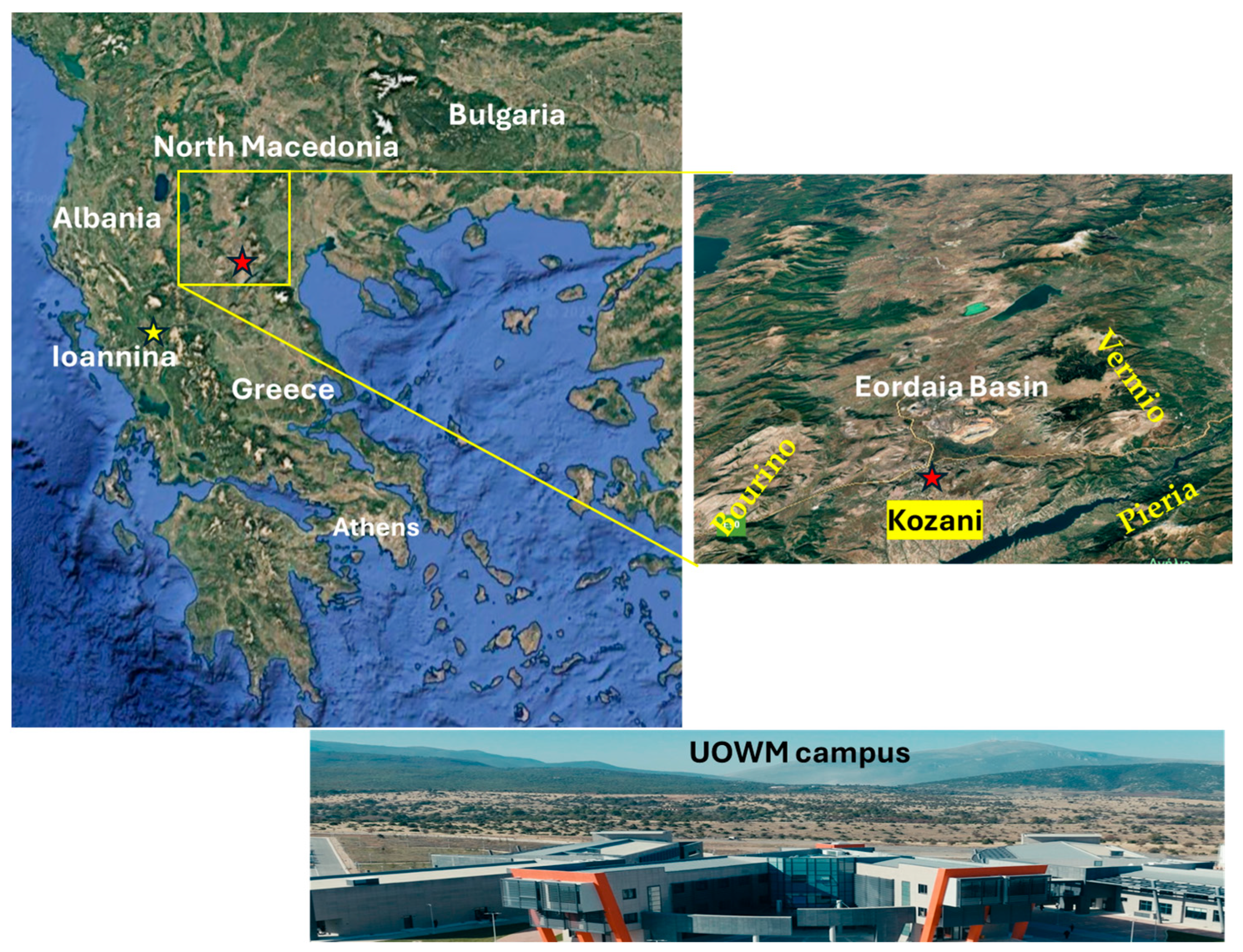
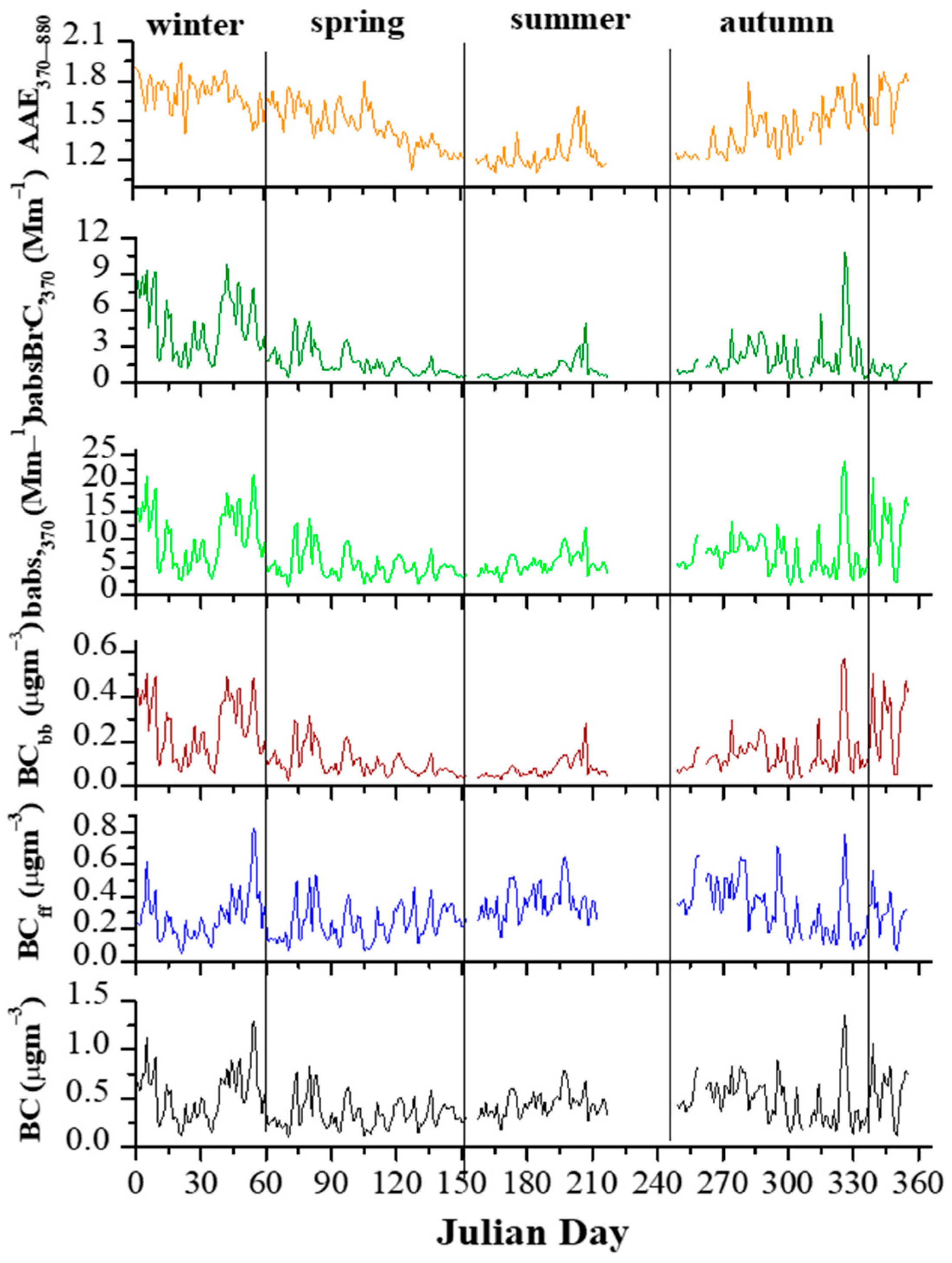
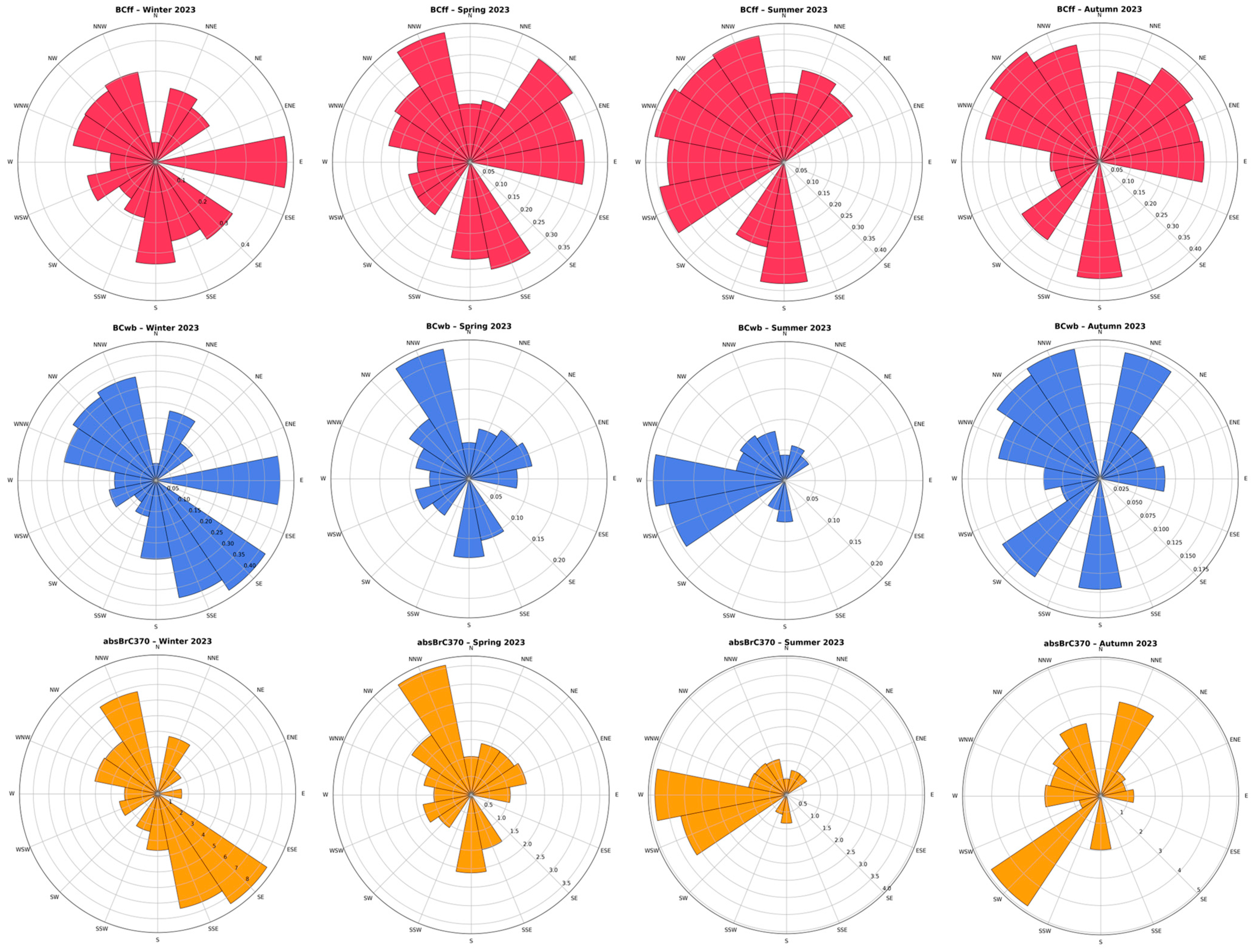
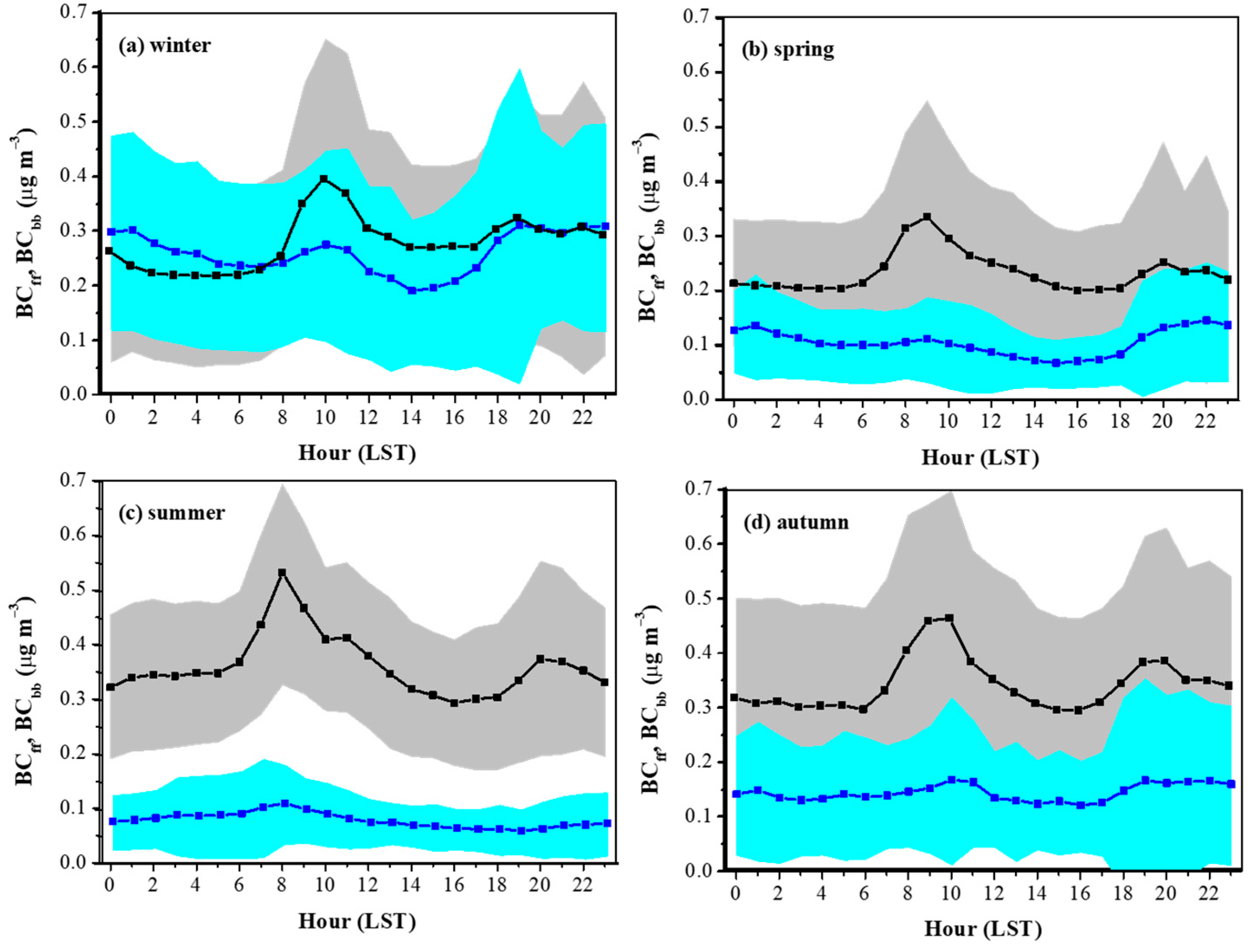
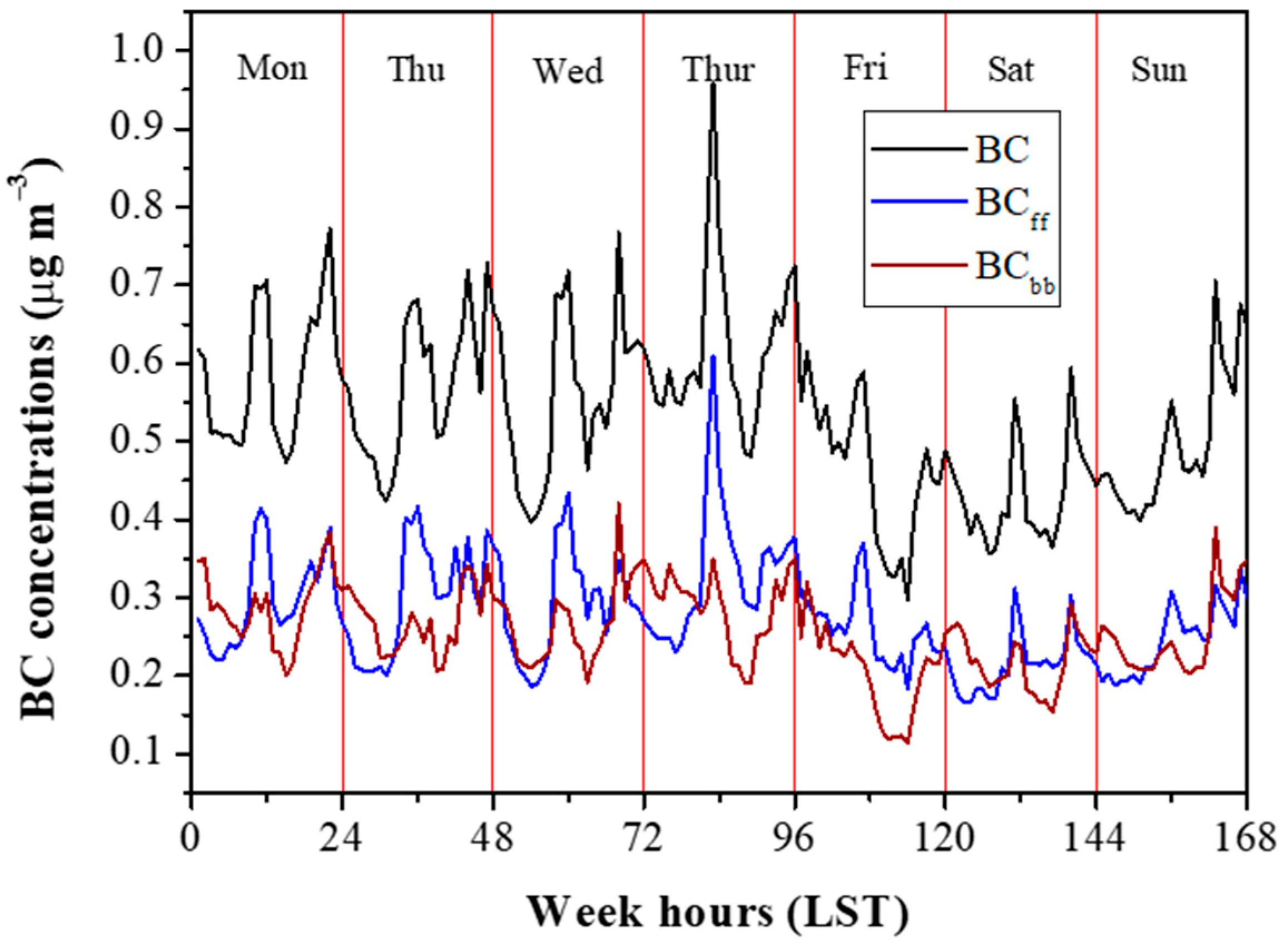

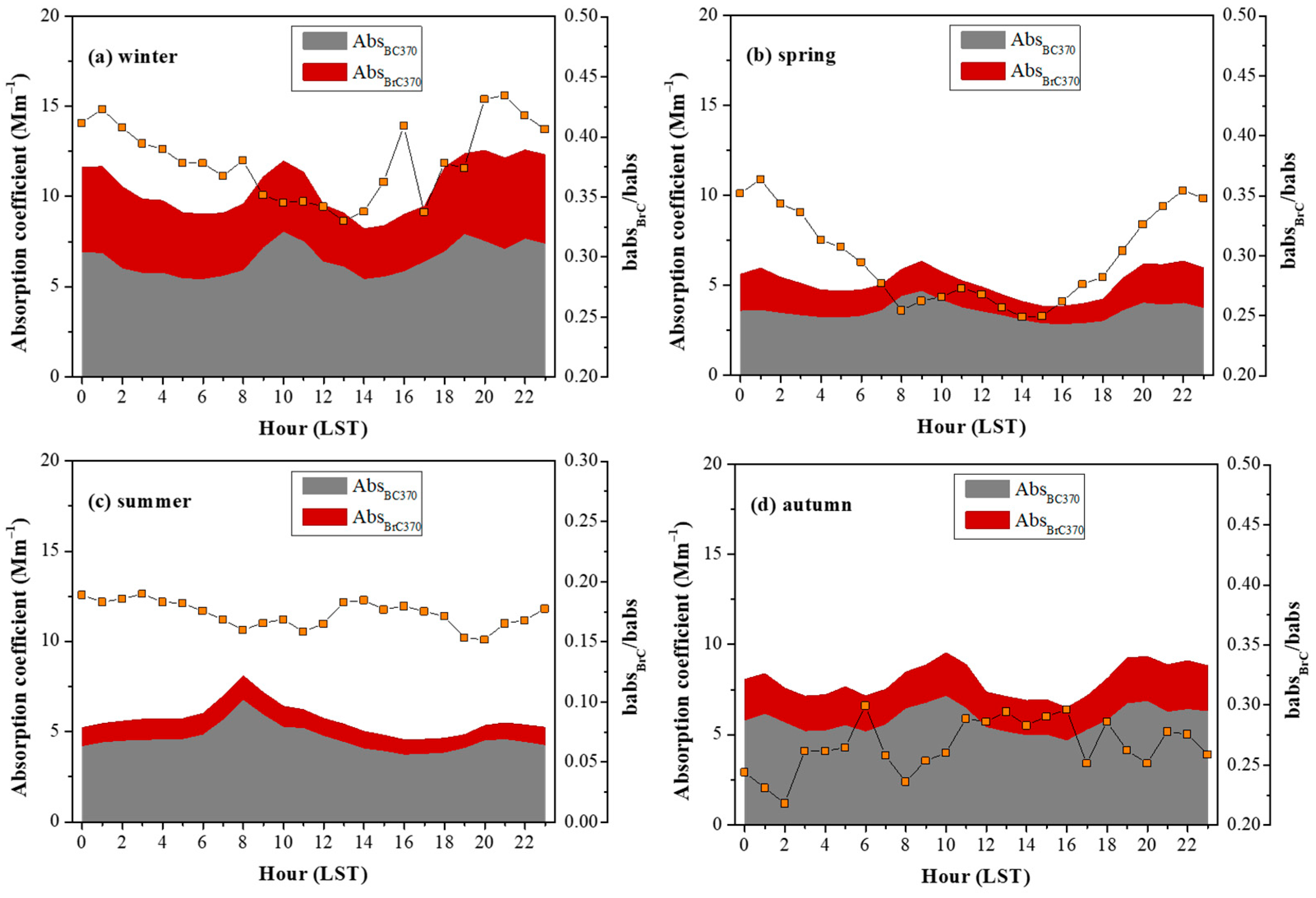
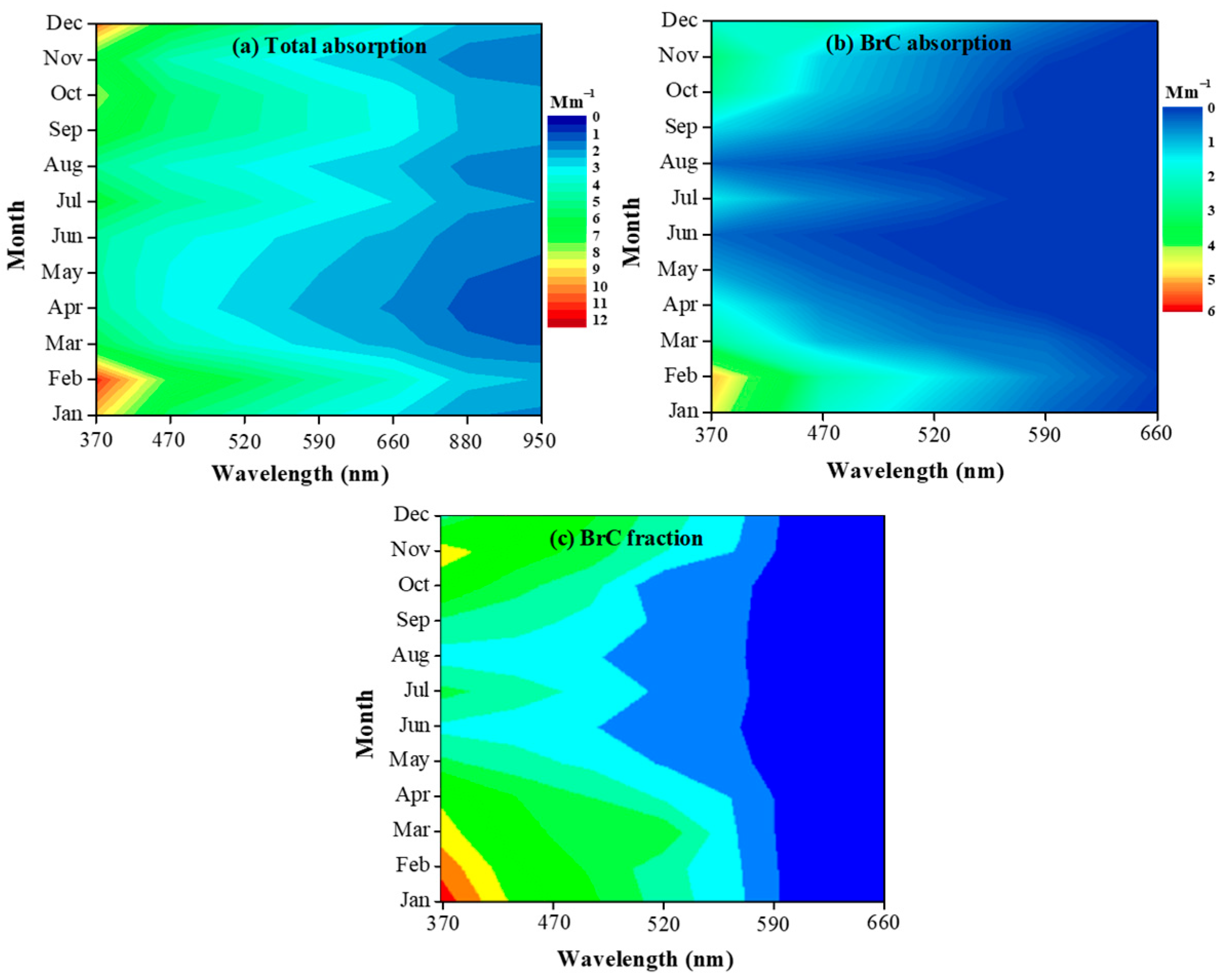
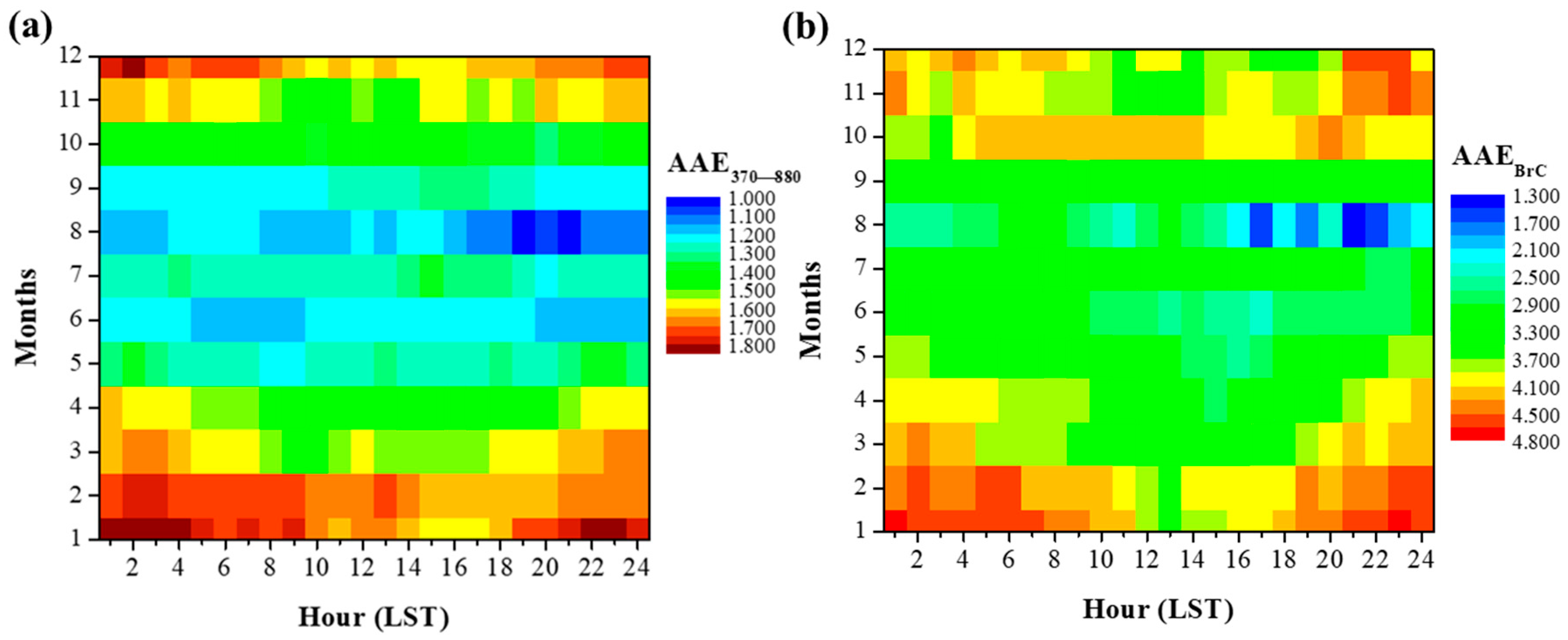
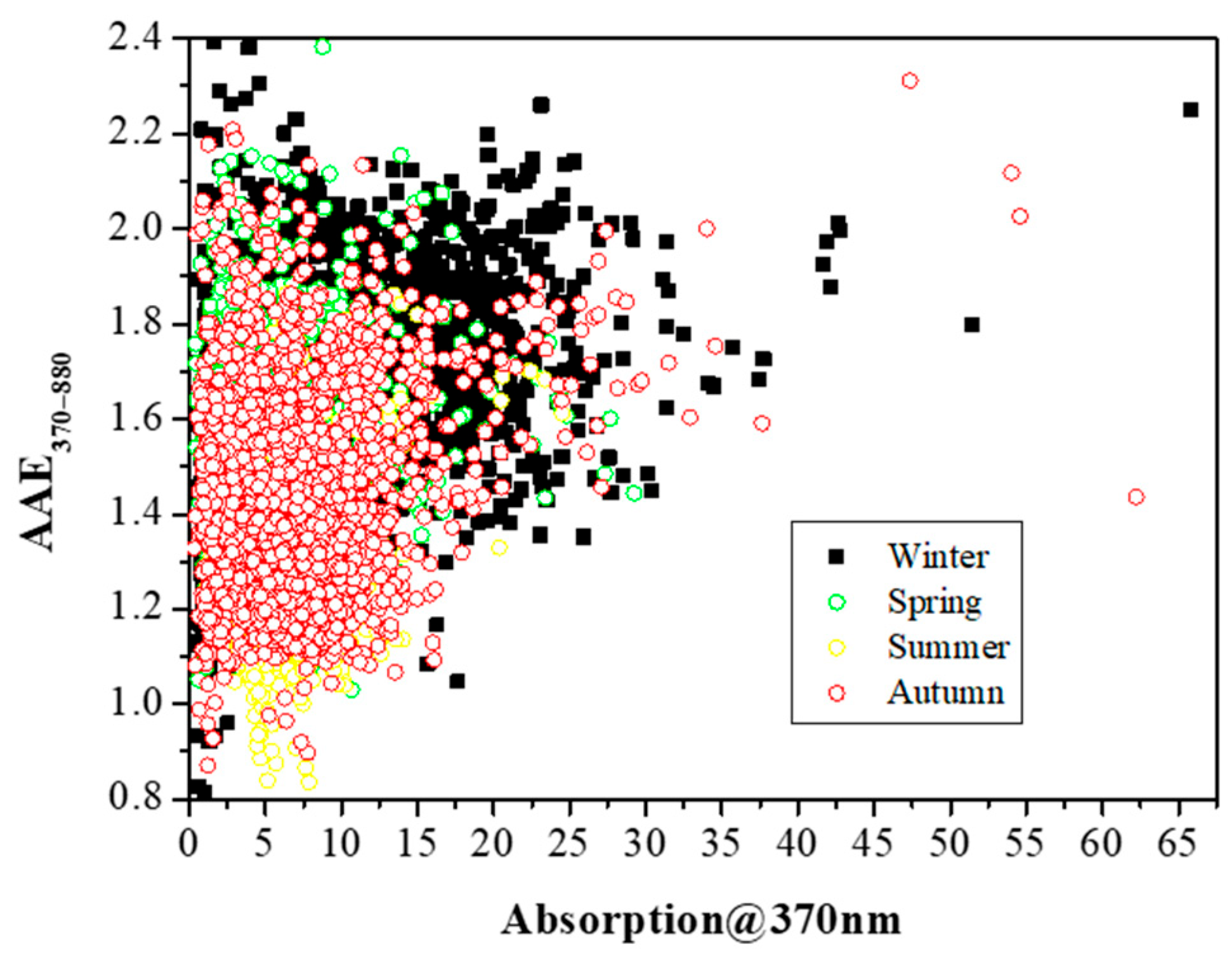
| Annual | Winter | Spring | Summer | Autumn | |
|---|---|---|---|---|---|
| Μean/Median/ StDev | Μean/Median/ StDev | Μean/Median/ StDev | Μean/Median/ StDev | Μean/Median/ StDev | |
| BC (µg m−3) | 0.44/0.39/0.27 | 0.53/0.48/0.33 | 0.34/0.30/0.20 | 0.44/0.41/0.18 | 0.48/0.45/0.30 |
| BCff (µg m−3) | 0.30/0.27/0.19 | 0.28/0.23/0.20 | 0.23/0.15/0.36 | 0.36/0.33/0.15 | 0.34/0.32/0.22 |
| BBbb (µg m−3) | 0.15/0.10/0.14 | 0.26/0.18/0.24 | 0.10/0.08/0.07 | 0.08/0.06/0.06 | 0.14/0.11/0.13 |
| BB% | 34.8/33.1/15.9 | 49.1/49.1/13.8 | 34.6/33.1/15.9 | 20.5/18.4/9.2 | 31.5/29.1/13.5 |
| Abs,370 (Mm−1) | 7.12/5.74/5.20 | 10.35/9.43/6.81 | 5.17/4.41/3.30 | 5.64/5.11/2.50 | 7.14/6.31/5.00 |
| Abs,520 (Mm−1) | 4.09/3.51/2.65 | 5.30/4.85/3.35 | 3.07/2.69/1.87 | 3.73/3.45/1.54 | 4.34/4.02/2.76 |
| AbsBrC,370 (Mm−1) | 2.26/1.29/2.82 | 3.99/2.81/4.14 | 1.63/1.16/1.48 | 1.04/0.73/1.05 | 2.18/1.81/2.45 |
| AAE370–880 | 1.47/1.43/0.25 | 1.69/1.70/0.21 | 1.46/1.43/0.20 | 1.24/1.21/0.10 | 1.42/1.39/0.22 |
| AAEBrC | 3.60/3.61/1.11 | 3.86/4.14/1.32 | 3.56/3.58/0.72 | 3.06/2.94/0.86 | 3.81/3.77/1.28 |
Disclaimer/Publisher’s Note: The statements, opinions and data contained in all publications are solely those of the individual author(s) and contributor(s) and not of MDPI and/or the editor(s). MDPI and/or the editor(s) disclaim responsibility for any injury to people or property resulting from any ideas, methods, instructions or products referred to in the content. |
© 2025 by the authors. Licensee MDPI, Basel, Switzerland. This article is an open access article distributed under the terms and conditions of the Creative Commons Attribution (CC BY) license (https://creativecommons.org/licenses/by/4.0/).
Share and Cite
Seraskeri, M.; Kontos, N.; Michalopoulos, M.I.; Kardolama, P.; Karava, M.V.; Tasiopoulou, I.E.; Garas, S.K.; Sotiropoulou, R.-E.P.; Kaskaoutis, D.G.; Tagaris, E. Unveiling Light-Absorbing Carbonaceous Aerosols at a Regional Background Site in Southern Balkans. Atmosphere 2025, 16, 644. https://doi.org/10.3390/atmos16060644
Seraskeri M, Kontos N, Michalopoulos MI, Kardolama P, Karava MV, Tasiopoulou IE, Garas SK, Sotiropoulou R-EP, Kaskaoutis DG, Tagaris E. Unveiling Light-Absorbing Carbonaceous Aerosols at a Regional Background Site in Southern Balkans. Atmosphere. 2025; 16(6):644. https://doi.org/10.3390/atmos16060644
Chicago/Turabian StyleSeraskeri, Martha, Nestor Kontos, Miltiades I. Michalopoulos, Paraskevi Kardolama, Marina V. Karava, Iliana E. Tasiopoulou, Stylianos K. Garas, Rafaella-Eleni P. Sotiropoulou, Dimitris G. Kaskaoutis, and Efthimios Tagaris. 2025. "Unveiling Light-Absorbing Carbonaceous Aerosols at a Regional Background Site in Southern Balkans" Atmosphere 16, no. 6: 644. https://doi.org/10.3390/atmos16060644
APA StyleSeraskeri, M., Kontos, N., Michalopoulos, M. I., Kardolama, P., Karava, M. V., Tasiopoulou, I. E., Garas, S. K., Sotiropoulou, R.-E. P., Kaskaoutis, D. G., & Tagaris, E. (2025). Unveiling Light-Absorbing Carbonaceous Aerosols at a Regional Background Site in Southern Balkans. Atmosphere, 16(6), 644. https://doi.org/10.3390/atmos16060644








